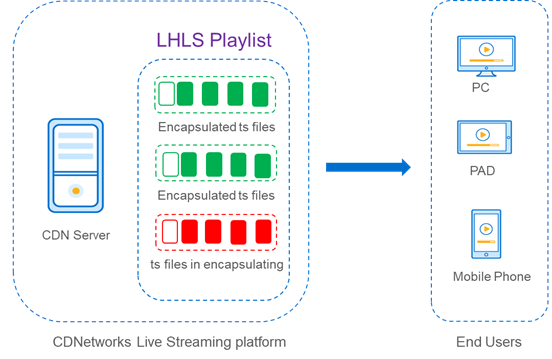LHLS
Last update:2022-04-14 10:04:35
1 VAS Intro
1.1 Brief Introduction
HLS (HTTP Live Streaming) is an HTTP-based streaming media network transmission protocol proposed by Apple. The working principle of HLS is to divide the entire stream into small HTTP-based files for download, and the process of rectifying and dividing the files introduces a large latency. In addition, in order to ensure the smoothness of video playback, the player has a limitation on the minimum number of files required to start playing, and this limitation further expands the latency of HLS. Under the current trend of pursuing low-latency live broadcast, the HLS protocol needs to have the ability to adapt to the trend.
The LHLS (Low Latency HLS) protocol, as the name suggests, is a protocol that aims to reduce the latency of the HLS protocol. The HLS player does not need to be modified and can directly support the LHLS protocol to reduce the latency of the HLS protocol, shorten the distance between end users and streamers, and improve the user experience.
1.2 Applicable Product Line
- Media Acceleration Live Broadcast.
1.3 Application Scenarios
All live streaming customers who is looking for low latency for HLS delivery.
2 Feature Detail
The working principle of LHLS (Low Latency HLS) is to respond the segment data of the server to the client in advance, thereby reducing the latency of HLS.

Procedures:
- End user initiates a request for m3u8 manifest file to the server.
- The server responds a m3u8 manifest file, which including 1 ts file url that is being encapsulated. When the number of ts file contained in the first manifest is 3, then the manifest file contains the url of 2 encapsulated ts files and another ts which is being encapsulated.
- Player reads the m3u8 file to get the url of the ts files and sends requests for the ts files to server in order.
- The encapsulated ts files will be directly given by the server, and the ts files still in encapsulating will be transferred by http chunk.
Notes: Client needs to carry a specific parameter in the request URL to trigger LHLS. The parameter is configurable.
3 Notices
- To use LHLS, the segmentation of ts files need to be done on CDNetworks servers.
- Audio only and Video only feature is not supported while using LHLS.